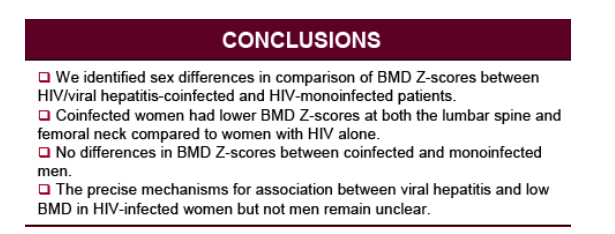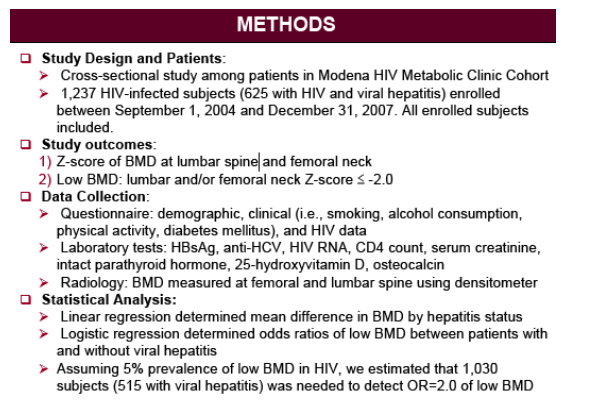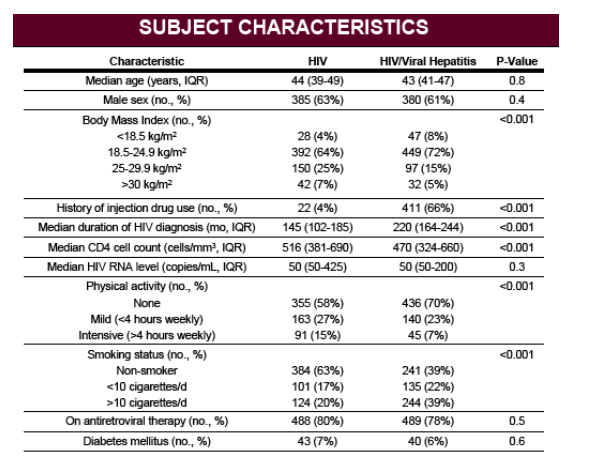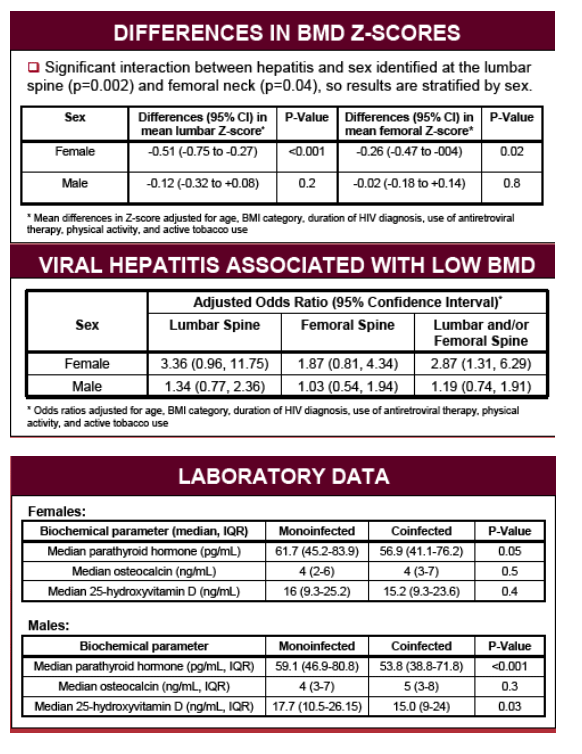 |
 |
 |
| |
Viral Hepatitis is Associated with Reduced
Bone Mineral Density in HIV-Infected Women but Not Men
|
| |
| |
Reported by Jules Levin
CROI Feb 8-12 2009 Montreal
V. Lo Re,1,2 G. Guaraldi,3 M. Leonard,2 R. Localio,2 J. Lin,1 V. Teal,2 G. Orlando,3 N. Squillace,3 L. Zirilli,4 V. Rochira,4 J. Kostman,1 P. Tebas1
1Infectious Diseases, 2Center for Clinical Epidemiology, Univ. of Pennsylvania and 3Infectious Diseases, 4Endocrine Unit, Univ. of Modena and Reggio Emilia
Funding Sources: NIH K01-AI070001 (Lo Re); U01-IA069467 (Penn ACTG, Tebas); P30-AI045008 (Penn CFAR, Tebas)
from Jules: I don't see any information collected on the amount of alcohol used. In the table on Laboratory Data men coinfected men had lower median parathyroid hormone than monoinfected men, similarly wit women. Coinfected men had lower median 25-hydroxyvitamin D than monoinfected men, but there was no difference between mono or coinfected women regarding vitamin D. Regardless of the findings in this study, the rate reported below in the Results section of 14% of study participants having ben found to have low bone mineral density is lower than found in cohort studies in the USA so my guess is there are other differences between this patient population and that in the USA. Cohort studies among HIV+ in the USA find 50-60% have osteopenia and 5-20% have osteoporosis, and at the stunningly low age of 45 yrs on average. Two studies in HIV+ find the fracture rate is increased among HIV+ compared to HIV-negatives, and fractures lead to fragility and mortality. Still, this study found coinfected women have more bone loss than HIV+ women, that of itself suggests a good reason to follow closely coinfected women for bone loss. In fact all HIV+ and certainly including HCV/HIV coinfected should receive baseline bone dexas. A reason this is not supported by thought leaders in HIV is because of the extra cost, which is NOT an issue for patients. Due to worrying about cost doctors and thought leaders want to short change patients. Get a bone dexa and follow it up!!!!!
AUTHOR CONCLUSIONS

Background: Viral hepatitis has been associated with reduced bone mineral density (BMD) in HIV-uninfected patients, but the mechanisms for bone loss remain unknown. To date, no study has yet examined if viral hepatitis is an independent risk factor for low BMD in HIV.
Objective: We examined if viral hepatitis coinfection was associated with reduced BMD among HIV-infected individuals.
Methods: We conducted a cross-sectional study among 1,237 HIV-infected subjects (625 with viral hepatitis) enrolled in the Modena HIV Metabolic Clinic Cohort. Dual-energy x-ray absorptiometry (DXA) scans of the lumbar spine and femoral neck were obtained. Clinical data, hepatitis B and C status, and markers of bone metabolism were determined at the DXA scan. Multivariable logistic regression examined the association between hepatitis and low BMD (Z-score <-2.0 at the lumbar spine and/or femoral neck).
Results: Mean BMD Z-scores were lower among hepatitis-coinfected women at the lumbar spine (difference=-0.44; p<0.001) and femoral neck (difference=-0.25; p=0.009) compared to HIV-monoinfected women, but differences in mean BMD Z-scores between coinfected and monoinfected men were not observed at either the lumbar spine (difference=-0.05; p=0.5) or femoral neck (difference=-0.08; p=0.2).
After adjustment for age, body mass index, duration of HIV infection, combination antiretroviral use, physical activity, and smoking, viral hepatitis was associated with low BMD among women (adjusted OR, 2.87; 95% CI, 1.31 - 6.29) but not men (adjusted OR, 1.19; 95% CI, 0.74 - 1.91). Coinfected women had lower median parathyroid hormone concentrations (56.9 versus 61.7 pg/mL; p=0.05) but similar median 25-hydroxyvitamin D (15.2 versus 16.0 ng/mL; p=0.4) and osteocalcin (4 versus 4 ng/mL; p=0.5) concentrations.
Conclusions: Viral hepatitis was associated with a higher risk of low BMD among HIV-infected women but not men.
BACKGROUND & STUDY AIM
5-10% of HIV-infected patients are coinfected with hepatitis B and 30% are coinfected with hepatitis C
Viral hepatitis has been associated with reduced BMD in HIV-uninfected patients, but mechanisms for bone loss are unknown.
Few studies have examined BMD in patients with HIV and viral hepatitis.
Evaluating the association between viral hepatitis and low BMD in HIV is important because: Viral hepatitis is prevalent in HIV
Low BMD is a predictor of fragility fractures and all-cause mortality
Specific Aim: To determine if viral hepatitis coinfection was an independent risk factor for low BMD in HIV-infected patients. Hypothesis: Viral hepatitis increases risk of low BMD in HIV.



|
| |
|
 |
 |
|
|